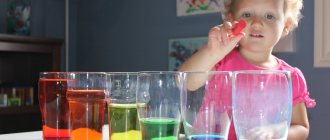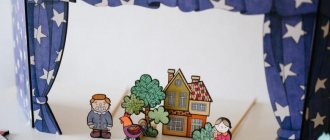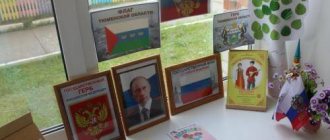How to organize distance learning with preschoolers in an interesting way: nine new ideas
How to organize distance learning with preschoolers in an interesting way:
nine new ideas
During the period of self-isolation, many teachers have already tried online classes with preschoolers. There were ideas that did not justify themselves and caused criticism from parents and psychologists. We have collected nine ideas for distance learning with preschoolers, for which parents will thank your teachers.
Conduct distance classes taking into account a comprehensive thematic plan and significant events of the month. This will make it easier for parents to reinforce a new topic with their child after watching the video lesson. Both children and parents should be prepared for distance learning. What day of the week to choose for this, see the memo for teachers. Select tasks that parents can complete with their child and even combine with household chores. The main task of an adult is to create conditions for learning, to interest the preschooler with new knowledge and a live meeting with the teacher.
Idea 1.
Video instruction.
Lifehack on how to teach a child to fold clothes!!! https://www.youtube.com/watch?v=-GCqjA5EeFw
The first problem that many parents faced during self-isolation was the mess in the child’s room. If in kindergarten children are accustomed to folding their things themselves before going to bed, then at home, when there is no teacher nearby, preschoolers have forgotten about this rule. Record a video instruction for them on how to fold clothes. Remind your students that they also need to keep order at home. To check how children perform this task, ask parents to photograph the process itself and the result - the child’s folded things. Parents can play this kind of video instruction for their child every day.
Idea 2.
Morning exercises live with a teacher or with your favorite characters via video call. Agree in advance at what time you will exercise with your children. If not all families can connect to the charger live, record a video and send them a link or link to the audio charger with the Clown PLUH.
Use movements and music familiar to children. The main thing is to recreate at home the routine that preschoolers are accustomed to in kindergarten. Children will be able to demonstrate to their parents how they can perform the exercises and control how mom or dad performs them. Such joint exercise will give all family members a charge of positive emotions for the whole day.
Idea 3.
Game “How to help Kuza?”
Another problem for parents these days is that the child interferes with household chores. Offer to organize a game with your child “How can I help Kuza?” Record a video message from the perspective of a familiar toy character that you use in group classes. For example, on behalf of the brownie Kuzi.
1
In your message, tell him that Kuza needs help. He forgot his chest in our center. And for him to appear at his home, you need to say the magic words. Kuzya handed the parents an envelope with tasks that the child must complete during the day and learn the magic word. One word for each child (children can be grouped into teams) Assignments include doing homework and any tasks the child can do around the house. Depending on the situation, parents can play this game for 2-3 days. At the end of the final day, parents and their child fold paper sheets with letters into a word, take photographs and send them to the teacher. The next day they receive a video of gratitude from Kuzi.
Such a game will not only help keep your child occupied at home, but will also evoke an emotional response in him and a desire to help the fairy-tale hero. It will develop the child’s creative imagination and imagination, and most importantly, it will help parents in a playful way to create a situation where the task must be completed.
Idea 4.
Culinary master classes
The kitchen has become the most visited room during the self-isolation period in many families. Moreover, parents here not only cook food, but also have to work while their children watch cartoons and play computer games in their rooms. But when children get tired of these activities, they move to the kitchen. Most often, parents shoo them back into the room so they don't accidentally spill something hot on themselves. However, educational problems can also be solved here.
Organize an online culinary master class for children and parents and offer to prepare, for example, fun scrambled eggs that the child can decorate with herbs himself. Or offer to take part in a sandwich competition. To do this, ask parents in advance to study interesting facts about sandwiches with their child.
During the competition, while mom is preparing the ingredients, conduct a quick quiz for preschoolers: what is the main component for a sandwich; what a traditional sandwich is made from; How is the word “sandwich” translated from German? what is the difference between a simple sandwich and a complex one? how to eat a sandwich to make it tastier (Matroskin’s cat rule). Then ask parents to take pictures of the finished sandwiches and send them to the general chat for voting.
Idea 5.
Didactic game “Guess what’s missing?”
Distance learning requires that an adult be present with the child. However, not all tasks require parents to sit with their child in front of the computer. It is necessary to provide preschoolers with the opportunity to demonstrate independence. Record a video of the didactic game “Guess what’s missing?” In class, children love to play this game, so the rules are familiar to them.
Take several large items so they can be easily seen. For example, scissors, a ruler, a book, a doll, a soft toy, a comb. Keep foreign objects out of the child's field of vision. Remind the rules of the game: look carefully at the objects on the table, remember them. Close and then open your eyes and guess what is missing. The parents' task is to make sure that the child does not open his eyes.
This game can be played offline, that is, recorded. In this case, it is important to pronounce the correct answer so that the child can check himself. Write down several such games with different subjects, including on different lexical topics. For example, hairdressing and stationery, vegetables, fruits. The game will develop children's memory, attention, observation, and grammatical structure of speech.
Idea 6.
Graphic dictation
Offer older preschoolers the task of completing a graphic dictation. The parents' task is to prepare the workplace so that the child is comfortable and ensure silence in the room. The task will require concentration and attentiveness from the child.
Take a notebook sheet in a square, since you will draw strictly according to the cells. It can be any figure, but not very large: a house, a tank, a dog, a fish, a robot. Calculate the time so that the child has time to complete the graphic dictation to the end during the lesson. The duration of the lesson is no more than 10–15 minutes.
Explain to your child that now you will draw with him in the cells, but do not tell him what kind of figure. To get a drawing, the child must listen carefully to which direction to draw the lines and how many cells to the right and left, count up and down. Then you begin to clearly pronounce the direction of movement of your hand and at the same time draw a picture on your sheet, the child on his. At the end of the lesson, you show the child your drawing on the screen, and the child checks to see if he did it right. This activity develops attention, listening skills, logic, spatial imagination, and also prepares the hand for writing. Recommend it to parents of pre-schoolers.
Idea 7.
Remote master class “Doing useful things”
One of the options for distance learning with children and parents is a master class, when the teacher shows how to make a craft with a child or draw a picture using an unconventional technique. Since the beginning of the self-isolation regime, there have been many such master classes, but teachers did not take into account what not everyone has at home, for example, colored napkins or wax crayons. The product of joint activity also raised questions among parents: what to do with it later. Therefore, it is better to conduct master classes and do things with children and parents that they will later use.
Idea 8.
Bragging Day
Each thematic week in kindergarten ends with a final event. Invite parents to hold a “Bragging Day” with their children in the form of a report and post their children’s achievements for the week in the chat. Children will brag about what they did: what pictures they drew, what sandwiches they made with their mother, what songs and poems they learned, how they helped their younger brother or sister, what tasks the teacher completed.
Parents can write down each child’s achievement on colored pieces of paper and collect them in a folder or pin them on a board, take photographs of children’s work, and record a video. Such collection of information will not only add to the portfolio of preschoolers, but will also make every day in self-isolation memorable.
Idea 9.
An audio tale from your favorite teacher or hero.
Self-isolation has shown that in many families there is no tradition of family reading; parents do not know how to interest their child in books. Some didn't even have children's books at home.
To organize a lesson on the perception of fiction with your children, record yourself reading a fairy tale and send parents a link to the video. Make a series of notes and each time announce the next fairy tale so that the children are waiting for it. In this case, it is better to use video rather than live broadcast. This way, parents will be able to play the recording for their child before bedtime, when he has already calmed down and is ready to listen.
REMINDER
for the teacher
15 recommendations on how to organize distance learning with children
- Plan activities with your children based on their age and the kindergarten activity plan. This way you can stick to the main topics that you should have covered with the children in the group.
- Discuss in advance with your parents what time you will conduct classes.
- Conduct classes on the days when children are most productive: Tuesday, Wednesday and Thursday.
- Conduct classes at the same time so as not to disrupt your daily routine.
- Conduct no more than 1 class per day and no more than 3 classes per week.
- Make sure that classes last no more than 10 minutes for children five years old and no more than 15 minutes for children six years old, 20-25 minutes for preschoolers and 30-40 minutes for schoolchildren.
- Provide classes in two formats: offline - when parents and their child watch a ready-made video recording of the lesson, online - when parents, their child and the teacher communicate live.
- Think over your lesson plan in advance to maintain its pace and not drag it out over time.
- Prepare the necessary materials in advance so as not to waste time during the live broadcast and avoid distractions.
- Make sure that there are no unnecessary objects on the screen that could distract children from the lesson.
- Divide educational video lessons into stages.
- Speak loudly, clearly, and take your time when communicating with children and parents live or recording video. Use more intonation in your speech than in normal conversation.
- Greet children and parents at the beginning of the lesson and announce the next lesson at the end.
- Repeat instructions so parents and children understand what the task is.
- Be sure to praise the children for completing the task.
Classification by content of knowledge
Other types of classes in preschool educational institutions can be divided according to the content of the knowledge gained. This can be a classic lesson when the children study the planned section of the program. It can be divided into several stages:
- explanation of a new topic;
- consolidating the material with questions on the topic or completing an assignment;
- summing up the work.
Another type of organization of the educational process in kindergarten is called an integrated lesson. What type of classes is this at a preschool educational institution? Let's look at this with the following example. For example, the teacher raises the topic “Sea”. Children discuss the composition of sea water, transport that moves on the waves, who lives in the depths of the seas, what grows in the water, what the bottom is covered with, how people relax at sea, what kind of entertainment there is on the water, etc.
The topics of classes in a preschool educational institution can be chosen as specific, for example, some kind of natural phenomenon, holiday or hero of a fairy tale, or general ones - a store, a forest, a bakery. In the first option, children receive expanded knowledge about something specific, and in the other, an understanding of the holistic picture of the work of an enterprise or store, the life of the forest, etc. is formed.
Types of activities
Types of classes in preschool educational institutions have several classifications. If we consider the solution to any didactic problem, then we can distinguish 4 points. These are the following types:
- mastering new material when the teacher explains to the children a topic planned according to the “Education Program”, or new practical skills are developed, for example, in modeling or drawing classes;
- consolidation of previously studied material - repetition of a poem, learned geometric figures or numbers, retelling a familiar fairy tale, didactic game “Name it correctly,” etc.;
- classes in which children use acquired knowledge and skills in the creative process, for example, coming up with the end of a story, making an application according to a plan on a certain topic, coming up with an addition or subtraction problem, completing a sentence, etc.;
- complex is a combination of different types of activities to master one task, for example, when studying the behavior of a squirrel, the teacher suggests guessing a riddle about the animal, looking at a picture, playing the game “What does a squirrel eat?”, listening to a song about this animal, while the teacher will tell about the habits the forest jumper, as she prepares for winter, will give the children the task of counting the number of nuts and mushrooms stored by the squirrel, and at the end will offer to draw the squirrel themselves according to the teacher’s model.
Consultation “How to make an activity interesting for a child?”
Victoria Usova
Consultation “How to make an activity interesting for a child?”
This question is asked both by the child’s parents, doing developmental tasks with him at home, and by specialists.
Why is it important?
Interest is an active cognitive focus on an object. An interested child will be happy to study a new subject, remember the necessary information, and actively use the acquired knowledge. Thus, interest stimulates the development of cognitive processes (attention, memory, thinking).
Interest is motivation. If a child is interested, he will complete any task, even complex ones.
Interest is directly related to positive emotions. Everything that brings joy to a child stimulates his development.
What can you do to make your child interested?
Present tasks in a playful way. For a preschooler, play is the leading activity that determines his development, but even for older children, the craving for play does not fade. Only the form changes: for kids you can use some kind of fairy-tale plot (or use its motifs, for example “The Adventures of Kolobok”, where completing each task allows the main character to escape from danger. For older children, board games, for example “adventure games”, become interesting: child rolls the dice, takes the required number of steps and receives the corresponding task, after completing which he can receive a certain number of points or a chance to continue the game.The most important thing is that the game makes sense (save Kolobok, score a certain number of points, receive a reward).
Offer new unusual tasks. For example, a child does not remember well. You ask him to memorize objects on the table, pictures, words... The child quickly gets bored with this. But you can memorize anything, anywhere: turn on excerpts from several songs and offer to repeat them, look carefully at the room, let the child go out, change something - will he notice? Encourage him to remember the shopping list when you go to the store. Believe me, there is a lot of information around that you can remember!
Use your favorite toys. Does your child love balls? Build your lesson around this interest: take a few balls, what size, shape, size are they? How many are there? Which one is missing? What's superfluous here? We’ll load the balls into the car and take them to the “clearing.” With a slight movement of the hand, the ball turns into a Kolobok or a turnip? Use your imagination and everything will work out!
Let your child feel the “taste of victory.” Even the most sophisticated toy can lose interest if suddenly something doesn’t work out. Help your child move towards success in small steps, believe in himself, and understand that he can do anything if he tries.
These simple tips will help you make your practice more effective.









